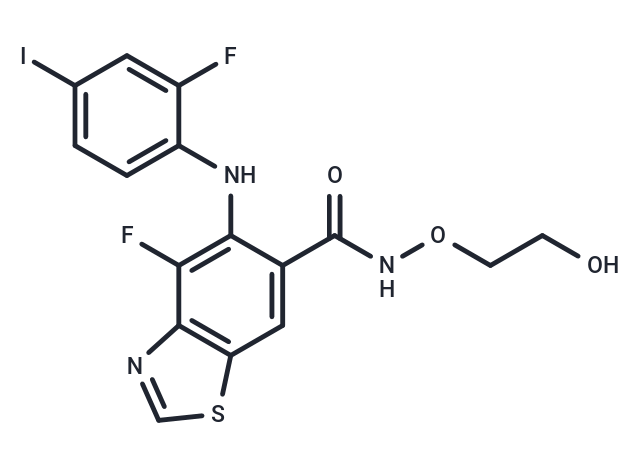 Your shopping cart is currently empty
Your shopping cart is currently empty

Tunlametinib is a highly selective, orally bioavailable small molecule inhibitor of MEK1 and MEK2 kinases with a reported IC50 value of 1.9 nM for MEK1. Tunlametinib exerts its antitumor effects by blocking the oncogenic RAS-RAF-MEK-ERK signaling pathway, thereby inducing tumor cell cycle arrest and promoting apoptosis, Tunlametinib demonstrates strong inhibitory activity against various RAS/RAF-mutant cancer cells such as those harboring BRAF V600E or KRAS G12C mutations, shows synergistic effects in combination with BRAF/KRASG12C/SHP2 inhibitors and Docetaxel, and is used in targeted therapy for RAS/RAF-driven cancers including melanoma, colorectal cancer, and non-small cell lung cancer (NSCLC).

| Pack Size | Price | USA Warehouse | Global Warehouse | Quantity |
|---|---|---|---|---|
| 1 mg | $66 | - | In Stock | |
| 5 mg | $158 | - | In Stock | |
| 10 mg | $248 | - | In Stock | |
| 25 mg | $397 | - | In Stock | |
| 1 mL x 10 mM (in DMSO) | $173 | - | In Stock |
| Description | Tunlametinib is a highly selective, orally bioavailable small molecule inhibitor of MEK1 and MEK2 kinases with a reported IC50 value of 1.9 nM for MEK1. Tunlametinib exerts its antitumor effects by blocking the oncogenic RAS-RAF-MEK-ERK signaling pathway, thereby inducing tumor cell cycle arrest and promoting apoptosis, Tunlametinib demonstrates strong inhibitory activity against various RAS/RAF-mutant cancer cells such as those harboring BRAF V600E or KRAS G12C mutations, shows synergistic effects in combination with BRAF/KRASG12C/SHP2 inhibitors and Docetaxel, and is used in targeted therapy for RAS/RAF-driven cancers including melanoma, colorectal cancer, and non-small cell lung cancer (NSCLC). |
| Targets&IC50 | A549 cells:59.89 nM, HT-291 cells:10.07 nM, COLO 205 cells:0.94 nM, HL-60 cells:0.67 nM, Colo-829 cells:3.46 nM, A375 cells:0.86 nM |
| In vitro | Methods: A375 cells were treated with tunlametinib (1-9 nM, 48 h) to evaluate the effects on the cell cycle. Results: Tunlametinib increased the proportion of A375 cells in the G0/G1 phase in a dose-dependent manner and induced cell cycle arrest. Methods: Tunlametinib was used to treat BRAF/KRAS mutant cell lines: A375, Colo-829, HL-60 melanoma cells, COLO 205, HT-29 colon cancer cells, Calu-6, A549 lung cancer cells, and cell viability was determined by MTS assay. Results: The IC50 values of tunlametinib in the above cells were 0.86 nM, 3.46 nM, 0.67 nM, 0.94 nM, 10.07 nM, and 59.89 nM. [1] |
| In vivo | Methods: Tunlametinib (1, 3, 6 mg/kg, oral, once daily for 21 days) was used to treat female BALB/c nude mice, NU/NU mice, or Nod-Scid mice bearing A375 (BRAF V600E mutant melanoma), COLO 205 (BRAF V600E mutant colon cancer), and Calu-6 (KRAS Q61K mutant lung cancer) tumors, and the tumor growth in vivo was observed. Results: Tunlametinib inhibited tumor growth in the above mice in a concentration-dependent manner. [1] |
| Synonyms | HL-085, HL085 |
| Molecular Weight | 491.25 |
| Formula | C16H12F2IN3O3S |
| Cas No. | 1801756-06-8 |
| Smiles | O=C(NOCCO)C1=CC=2SC=NC2C(F)=C1NC3=CC=C(I)C=C3F |
| Relative Density. | no data available |
| Storage | Powder: -20°C for 3 years | In solvent: -80°C for 1 year | Shipping with blue ice/Shipping at ambient temperature. | |||||||||||||||||||||||||||||||||||
| Solubility Information | DMSO: 80 mg/mL (162.85 mM), Sonication is recommended. | |||||||||||||||||||||||||||||||||||
| In Vivo Formulation | 10% DMSO+40% PEG300+5% Tween-80+45% Saline: 5 mg/mL (10.18 mM), Sonication is recommeded. Please add the solvents sequentially, clarifying the solution as much as possible before adding the next one. Dissolve by heating and/or sonication if necessary. Working solution is recommended to be prepared and used immediately. The formulation provided above is for reference purposes only. In vivo formulations may vary and should be modified based on specific experimental conditions. | |||||||||||||||||||||||||||||||||||
Solution Preparation Table | ||||||||||||||||||||||||||||||||||||
DMSO
| ||||||||||||||||||||||||||||||||||||
| Size | Quantity | Unit Price | Amount | Operation |
|---|

Copyright © 2015-2026 TargetMol Chemicals Inc. All Rights Reserved.